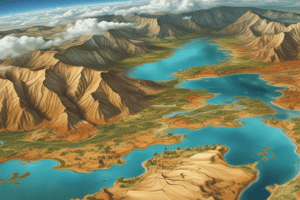Podcast
Questions and Answers
Which property of a pixel defines its intensity of spectral response in a particular band?
Which property of a pixel defines its intensity of spectral response in a particular band?
- Radiometric property
- Spatial property
- Spectral property (correct)
- Temporal property
What does spatial resolution primarily refer to in remote sensing?
What does spatial resolution primarily refer to in remote sensing?
- The frequency of time a location is observed
- The size of the area that can be observed at one time
- The range of wavelengths used in imaging
- The smallest discernible features in an image (correct)
What is the Instantaneous Field of View (IFOV)?
What is the Instantaneous Field of View (IFOV)?
- The wavelength range utilized by the sensor
- The spatial resolution limit of a sensor
- The angle extended by a single detector on the sensor (correct)
- The total area captured in a single image
Which factor does NOT affect spatial resolution?
Which factor does NOT affect spatial resolution?
If a sensor has a longer focal length, what is the expected outcome regarding its field of view?
If a sensor has a longer focal length, what is the expected outcome regarding its field of view?
Which resolution defines how often a particular area is observed?
Which resolution defines how often a particular area is observed?
Which of the following factors is most likely to increase spatial resolution?
Which of the following factors is most likely to increase spatial resolution?
Which resolution is focused on the degree of detail observed in the image?
Which resolution is focused on the degree of detail observed in the image?
What is the effect of a narrow spectral bandwidth on spectral resolution?
What is the effect of a narrow spectral bandwidth on spectral resolution?
Which of the following combinations ensures both good spatial and radiometric resolution?
Which of the following combinations ensures both good spatial and radiometric resolution?
What is necessary for effective differentiation of signal from noise?
What is necessary for effective differentiation of signal from noise?
Which type of composite image is created using the three primary colors of red, green, and blue?
Which type of composite image is created using the three primary colors of red, green, and blue?
What results from a fine spatial resolution in regards to energy detection?
What results from a fine spatial resolution in regards to energy detection?
What is a characteristic of multispectral images?
What is a characteristic of multispectral images?
How does poor spectral resolution affect energy detection?
How does poor spectral resolution affect energy detection?
What type of sensor typically detects light reflectance in multiple bands of the electromagnetic spectrum?
What type of sensor typically detects light reflectance in multiple bands of the electromagnetic spectrum?
What does a smaller scale fraction, such as 1:50,000, indicate about the representation of objects in an image?
What does a smaller scale fraction, such as 1:50,000, indicate about the representation of objects in an image?
How is Ground Sample Distance (GSD) related to flight height?
How is Ground Sample Distance (GSD) related to flight height?
Which of the following best describes detectability in spatial resolution?
Which of the following best describes detectability in spatial resolution?
In aerial photography, if an image has a scale of 1:15,000, how long would a bridge measuring 0.25 inches in the photograph be in reality, in feet?
In aerial photography, if an image has a scale of 1:15,000, how long would a bridge measuring 0.25 inches in the photograph be in reality, in feet?
What is a characteristic of a digital image compared to a photographic image?
What is a characteristic of a digital image compared to a photographic image?
What does the term spectral resolution refer to in a satellite imaging system?
What does the term spectral resolution refer to in a satellite imaging system?
The ability to identify objects such as distinguishing cars from trucks in an image is referred to as which of the following?
The ability to identify objects such as distinguishing cars from trucks in an image is referred to as which of the following?
Which of the following represents a limitation of a photographic image in terms of resolution?
Which of the following represents a limitation of a photographic image in terms of resolution?
What does spectral resolution refer to in satellite imaging systems?
What does spectral resolution refer to in satellite imaging systems?
Which factor does NOT influence temporal resolution in a satellite imaging system?
Which factor does NOT influence temporal resolution in a satellite imaging system?
What describes the relationship between radiometric resolution and the number of digital levels?
What describes the relationship between radiometric resolution and the number of digital levels?
If an image has a radiometric resolution of 8 bits, what is the maximum value of the digital number that can be represented?
If an image has a radiometric resolution of 8 bits, what is the maximum value of the digital number that can be represented?
How does finer radiometric resolution affect an imaging system's performance?
How does finer radiometric resolution affect an imaging system's performance?
What is the computed number of values for a digital image with a radiometric resolution of 6 bits?
What is the computed number of values for a digital image with a radiometric resolution of 6 bits?
Which of the following does not contribute to the temporal resolution of satellite data?
Which of the following does not contribute to the temporal resolution of satellite data?
Which statement is true regarding multi-spectral satellite imaging systems?
Which statement is true regarding multi-spectral satellite imaging systems?
What is a key characteristic of hyperspectral sensors?
What is a key characteristic of hyperspectral sensors?
When creating a natural composite image using the SPOT HRV scanner, which bands are combined for the color representation?
When creating a natural composite image using the SPOT HRV scanner, which bands are combined for the color representation?
What type of applications can benefit from hyperspectral image interpretation?
What type of applications can benefit from hyperspectral image interpretation?
Which of the following is NOT a primary application of hyperspectral sensors?
Which of the following is NOT a primary application of hyperspectral sensors?
What type of information does the spectral library provide in hyperspectral image interpretation?
What type of information does the spectral library provide in hyperspectral image interpretation?
Which process helps identify targets based on pixel spectra in hyperspectral imaging?
Which process helps identify targets based on pixel spectra in hyperspectral imaging?
Which application area includes monitoring glacier dynamics?
Which application area includes monitoring glacier dynamics?
Which type of mapping is involved in natural resource management?
Which type of mapping is involved in natural resource management?
What does a composite curve indicate in hyperspectral imaging?
What does a composite curve indicate in hyperspectral imaging?
Which of the following is a primary benefit of using a natural composite image?
Which of the following is a primary benefit of using a natural composite image?
Flashcards are hidden until you start studying
Study Notes
Nature of the Image
- Pixel: Basic unit in imaging with spatial and spectral properties.
- Spatial Property: Represents the height and width of ground features.
- Spectral Property: Indicates intensity of spectral response in a specific band.
- Sample Components:
- Buildings: 15% coverage, 90% reflectance.
- Sand: 15% coverage, 100% reflectance.
- Trees: 50% coverage, 50% reflectance.
- Water: 20% coverage, 10% reflectance.
Image Resolution Types
- Spatial Resolution: Defines the smallest detail visible in an image; high resolution allows for discernible small features.
- Spectral Resolution: Refers to the wavelength range detected by the sensor; narrower bands enhance resolution.
- Radiometric Resolution: Measures the sensor's detail observation capability; more levels allow for finer detail.
- Temporal Resolution: Indicates observation frequency depending on satellite orbit, target latitude, and sensor swath width.
Spatial Resolution
- Coarser resolutions obscure small features, while finer resolutions reveal them.
- Influencing Factors: Atmosphere, haze, smoke, sensor clarity, pixel size, and Instantaneous Field of View (IFOV).
- IFOV: Angle of visibility for sensor detection, affecting spatial resolution.
- Shorter focal lengths yield wider fields of view; longer lengths provide smaller footprints.
Image Scale
- Scale represents the distance on an image versus the corresponding ground distance.
- Large scale (e.g., 1:50,000) shows objects clearly; small scale (e.g., 1:250,000) renders objects less discernible.
- Ground Sample Distance (GSD): Distance between pixel centers, greater height results in larger GSD and lower resolution.
Interpretability in Spatial Resolution
- Detectability: Ability to record an object’s presence even if it's below the operational capacity.
- Recognizability: Identifying objects correctly; can be detected but not recognized.
- Identification: Distinguishing features such as vehicle types or tree species.
Spectral Resolution
- Spectral resolution is determined by bandwidths of detected bands; narrow bands provide greater resolution.
- Multispectral sensors record data across multiple bands, combining them to form color images.
Types of Composite Images
- True Color Composite: Combines primary color bands (red, green, blue) captured by sensors.
- False Color Composite: Uses arbitrary color assignments to identify distinct ground features, especially when primary bands are not available.
- Natural Composite Image: Resembles a visual photograph created from available spectral bands.
Hyperspectral Sensors
- Capture numerous narrow spectral bands, enabling detailed reflectance spectrum construction.
- Typically more than 100 bands recorded, facilitating advanced spectral analyses via imaging spectrometers.
Remote Sensing Applications
- Geological: Includes mapping surface deposits, mineral exploration, environmental geology, and hazard mapping.
- Hydrological: Encompasses wetland mapping, flood monitoring, and groundwater exploration.
- Land-Use: Addresses wildlife habitat protection, urban development, and damage assessment from disasters.
- Oceanographic: Involves ocean monitoring, storm forecasting, and oil spill response.
Signal to Noise Ratio
- Defined as the ratio of signal power to background noise; high SNR simplifies differentiation between the two.
Balancing Resolutions
- Fine spatial resolution typically correlates with small IFOV but may lead to lower energy detection capabilities.
- Successful imaging requires a balance between spatial, spectral, and radiometric resolutions tailored to specific objectives.
Studying That Suits You
Use AI to generate personalized quizzes and flashcards to suit your learning preferences.




